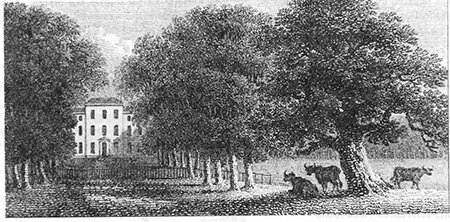Stubbers
/Stubbers was once the home of plantsman William Coys (1560-1627), who is credited with growing Yucca gloriosa which first flowered at Stubbers in 1604. In the same year the Flemish physician and botanist Matthias L’Obel recorded many bulbs growing at Stubbers including Colchicum, Crocus, Allium, Fritillaria and Hyacinth.
Stubbers, from Peacock’s Polite Repositry, 1804, Nigel Temple Collection, GT.
William Coys collected both native and exotic plants and seeds for his garden at Stubbers and his collection could be considered to predate the earliest botanical garden in Oxford (founded in 1621). It was already established and well-known to John Gerard in 1597. The earliest of Coys’ plant lists (1616-1617) is the ‘oldest known manuscript list of an English garden, in which the plants are properly distinguished by their scientific names’ (Gunther, 1922).
It was to Stubbers that the Ivy-leaved Toadflax, Cymbalaria muralis, and the Yellow Figwort, Scrophularia vernalis were brought from Spain by the Flemish plant hunter Dr. William Boel; here that the tomato – or love apple, Solanum lycopersicum - from Central America was grown (although not appreciated for its eating qualities); and it was here, in 1617, that the Jerusalem Artichoke, Helianthus tuberosus (from North America) was planted (given by his friend John Goodyer who described it as causing: ‘a filthie loathsome stinking winde within the bodie, thereby causing the belly to bee pained and tormented, and are a meat more fit for swine than men’).
William Coys also studied the new art of beer brewing and the culture of yeast, which were printed in 1605 by L’Obel, and his account helped to make ‘English Beer, from Barley and Hops famous in Netherland, for England yields plenty of Hops’ (Moryson, 1617).
The flower garden at Stubbers was seemingly situated at the south-east corner of the house, in what became known as the Mulberry Garden (Gunther, 1922), and it has been surmised that there were between 5 and 6 walled gardens (Smith, 1996) to grow his large collection of plants.
Stubbers was sold out of the Coys family in 1642, and thereafter passed through several owners until it was bought in 1689 by Sir William Russell.
In 1796 Humphry Repton was called in by the great grandson, another William Russell, to redesign the grounds, which resulted in the destruction of Coys garden. Excavations in the 1970s revealed remnants of Repton‘s garden walls and pavilion. There is a surviving walled garden (but when this was constructed is not certain). The Repton Red Book on Stubbers (which is very badly fire damaged) is held at the Albert Sloman Library, University of Essex (although its present location is actually at ERO whilst the conservators there try to restore it).
photo of Stubbers, Garden Front, in decay, 1959, ERO.
The house was demolished in 1960 and the grounds are now home to a very popular not-for-profit adventure activity centre, utilising the lakes and hillocks which resulted from gravel extraction in adjacent fields in the 1970s, whilst the walled garden is presently used as a wedding venue.
Stubbers, Ockendon, was the subject of a garden restoration project by a team of enthusiastic botanic historians in the 1980s but the work was not continued, and the knowledge and expertise dissipated.
This site is now part of the London Borough of Havering and you can find more information from London Parks and Gardens Trust here.
Read more about William Coys here.



